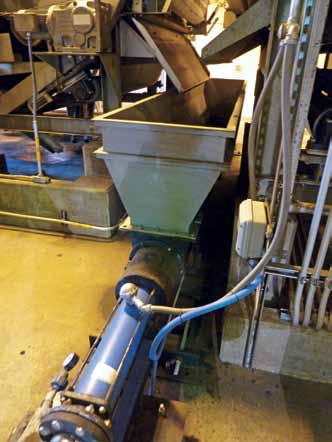Replacing conveyors with pumps improves efficiency and sanitation in an Ohio wastewater treatment plant.
A Delaware, Ohio, wastewater treatment plant needed a solution to replace its conveyer system. Delaware is a small Ohio city located about 30 miles north of Columbus. The city's 34,000 residents rely on a functioning wastewater treatment system as they continue to grow throughout the next decades. Delaware retains its small town vibe while also offering the benefits of a major city. Business is growing, so the need for wastewater treatment will grow with it.
The treatment plant in Delaware is responsible for all domestic and industrial wastewater from within the city along with the disposal of the sewage sludge produced during the wastewater treatment process. The expanded facility is capable of handling 10 million gallons per day. After the solids separation, the sludge is belt pressed to an approximate 20 percent solids content.

The progressive cavity cake pump with a reinforced hopper
The Problem
Conveyers are costly and difficult to maintain due to their many moving parts. Previously, the dewatered sludge fell onto a conveyer which would transport the sludge into dump containers, which would later be hauled to a landfill. The rectangular dump containers would frequently have to be moved with a front-loader to assure proper distribution of sludge. The conveyors were messy. Dewatered sludge would often fall onto the floor and require clean up. Odor was also a problem, making this a dirty job that even Mike Rowe would avoid.
Conveyor upkeep was tedious and expensive. Many moving parts mean that there is a higher chance of something eroding and breaking. It is impossible to stock all the parts and ordering replacements can take a long time and is expensive.
The Solution
The operators at the plant contacted a local distributor. After analyzing the problem, distributor and engineers from a progressive cavity pump (PCP) company came to the conclusion that a load cell controlled progressive cavity cake pump was a potential solution. When compared to a conveyer, the pump would result in a $1,500 per square foot capital cost savings. The distributor worked closely with Dwight Miller and Gerald Glenn from the city of Delaware to configure this solution. An open hopper pump was installed. It has a conveying capacity of 14 to 18 gallons per minute. The pump can handle up to 35 percent dry solids content.
The feed screw moves the cake into the compression zone at a rate that is three times greater than the physical capacity of the pumping elements. The high shear of the feed screw and circulation of the thixotropic sludge reduces the apparent viscosity, so it is easier and more efficient to pump. A custom hopper was installed for full containment of dewatered sludge coming from the belt press.
This cake pump was fitted with load cell sensors on a specially designed base plate. The sensors were integrated into a VFD and proportionally controlled by a panel that totalizes and buffers the signals coming from the load cells. The speed of the pump is adjusted according to the weight within the pump hopper. At higher levels, the speed increases. At lower levels, the pump slows. No operator is required to monitor the operation of the pump. A thermally actuated sensor is installed in the pump stator to prevent any run-dry damage. The sludge is moved through six-inch pipe to the dump containers. A series of valves allows operators to evenly distribute the sludge within the containers without using heavy equipment, eliminating the need for a front loader.
In this case, the dewatered cake travels through about 15 feet of pipe. In other instances, the distance may be greater. The pump manufacturer for this situation would offer a boundary layer injection system, which includes an injection ring and a metering pump. When polymer solution from the belt press day tank is used as a boundary layer, pressures from pipe friction losses can be reduced by more than 80 percent.
Once installed, operators noticed that due to the length of the custom hopper, additional reinforcement was needed. The problem was solved by adding the reinforced hopper.
The Successful Results
Glenn says, “I'm glad these machines are working for us now. Before (with the conveyors), it seemed we were doing all the work anyway.”
The pump has been running problem free for two years, with the only maintenance being a recent change of the stator. The PCP has effectively contained the odor, solved the dump container issue and reduced capital and maintenance costs and down time.
Pumps & Systems, October 2011

